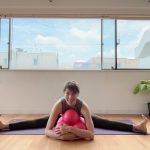
みなさん、こんにちは!初めましてm(__)m
2月から月2回、クラシカル・ハタヨガ(バイリンガルクラス)を
担当させていただいている、ララです。よろしくお願いします!
アルイマYogaでクラシカル・ハタヨガのレッスンを持ち始めてまだ2か月もしないんですが、
来週からラマダンの一か月が始まり、私は30日間日中断食をしますので、いきなりですが、
3月26日(日)と4月9日(日)のレッスン内容を運動量の少ない「陰ヨガ」に変更しています!
陰ヨガでは、ポーズをいつもの数呼吸ではなく、3分~5分と長く保ちます。
えっ?そんなに?!と聞かれることしばしば。
しかし、陰ヨガでは、いつものアクティブなポーズではなく、積極的にプロップスを取り入れ、
筋肉の力を抜いて、重力に身を委ねた形で状態でポーズを保ちますので、ゆっくりと呼吸と心を観察しながら、
「今ここ」を味わいながら、自律神経を整えてリラックスする効果があり、瞑想要素の高いタイプのヨガです。
YouTubeでもいくつかレッスンをアップしていますので、どんなヨガなのか興味のある方是非ご覧いただき、
気に入っていただけたら3月26日と4月9日、是非アルイマYogaで一緒に練習しましょう!
下記に陰ヨガについてまとめてみました。少しでも興味があれば是非レッスンにいらしていただけると嬉しいです!
陰ヨガ実践のの三つのポイント
①ポーズに入る時は、自分の「エッジ」を探る。
(*エッジとは、刺激が強すぎず、ストレッチを居心地よく保つことができる深さ。いつもの8割程度)
②動かないと、心の中で決意。
③ポーズを長く保つ。
陰ヨガの効果
・心を鎮静、心身のパランスを整える
・ストレスや不安の軽減
・血行促進
・関節と結合組織に働きかけるため、柔軟性アップ
・内臓を整える
・プラーナ(気)の循環を促す
アーユルヴェーダ視点
ヴァータ・ピッタを鎮める
カパを増やす
注意点
・過剰の負担をかけない(無理にポーズを深めようとしない。)
・痛みや違和感を感じたらポーズをリリースする(無理に我慢しない)
・体を冷やさない(運動量が少なく、ほぼ動かないタイプのヨガなので居心地よく過ごせるように、長袖のトップスを着たり、靴下を履いたり自分なりの冷え対策をする)
<<ENGLISH FOLLOWS>>
Hello yogis! My name is Lara and I have been teaching Classical Hatha Yoga twice a month at Aruima Yoga since February. My classes are bilingual, and I teach mostly in English and add Japanese as necessary. I’ve been really excited about joining the staff at Aruima Yoga and getting back into teaching again, after a hiatus lasting about a couple of years — but most of all, I am really excited to practice with yogis and yoginis from all backgrounds!
While it’s been barely a couple of months since I started teaching at Aruima Yoga, today I’d like to announce that on March 26 (Sunday) and April 9 (Sunday), I will be teaching Yin Yoga instead of my regular Classical Hatha Yoga class. This is because I will be fasting for Ramadan starting early next week, and I would rather focus on a less active and more introspective type of yoga during this time.
When we practice Yin Yoga, we stay in the poses anywhere between 3 to 5 minutes (and sometimes more), which is much longer than we usually do in other types of yoga. Many people react to this information with surprise, and find the longer holds daunting. However, it’s important to note that, in Yin Yoga, we don’t take the poses actively, but rather we make use of props in order to help ourselves to maintain the pose so that we can relax our muscles and surrender to gravity. We can then focus on observing the breath and the mind and staying presence, which helps balance our parasympathetic nervous system, leading us into a deep state of relaxation.
I have a few Yin Yoga classes uploaded on my YouTube channel (linked above) — please do give them a look to get an idea of what to expect and, if you’re interested, I’d love to practice together at Aruima Yoga on March 26 (Sunday) or April 9 (Sunday)!
More useful pointers on Yin Yoga:
3 Yin Yoga Principles
①When you enter a pose, find your edge.
(By “edge”, we mean that spot where you are feeling the stretch but can hold it comfortably and without pain. This can be about 80% of the depth you usually go into a pose, but may vary.)
②Resolve to remain still.
③Hold the pose.
Yin Yoga Benefits
・Calms and balances body and mind
・Helps relieve stress and anxiety
・Promotes blood circulation
・By working on joints and fascia, it may help improve flexibility
・Balances internal organs
・Promotes the circulation of prana (life energy)
From an Ayurvedic perspective
Calms Vata and Pitta / May aggravate Kapha
Important
・When practicing Yin Yoga, do not strain yourself (do not try to deepen a pose by force)
・If you feel pain, numbing or tingling, release the pose (a little discomfort when holding a stretch is normal — pain is not)
・Keep yourself warm (since we don’t move a lot when we practice Yin Yoga, you may find yourself feeling cold. Make sure to wear warm clothing such as long sleeves and socks, so you can maintain a comfortable body temperature)
ララ





